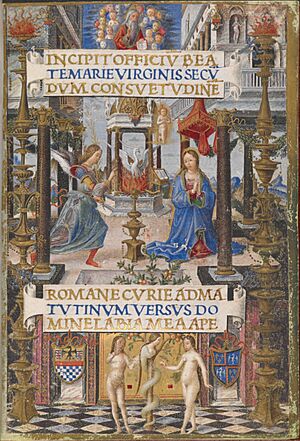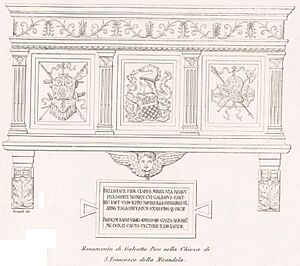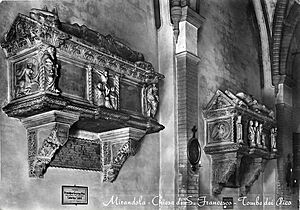Galeotto I Pico facts for kids
Quick facts for kids Galeotto I Pico |
|
|---|---|
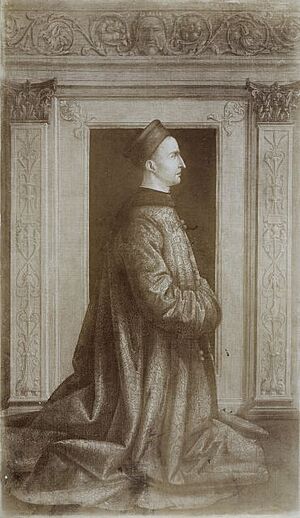 |
|
| Galeotto I (Palazzo Schifanoia, Ferrara) | |
|
|
|
| Coat of arms | 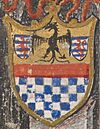 |
| Reign | 8 November 1467 - 9 April 1499 |
| Predecessor | Gianfrancesco I Pico |
| Successor | Giovanni Francesco Pico della Mirandola |
| Spouse(s) | Bianca Maria d'Este |
| Noble family | Pico Family |
| Father | Gianfrancesco I Pico |
| Mother | Giulia Boiardo |
| Born | 3 August 1442 Mirandola, Italy |
| Died | 9 April 1499 (aged 56) Mirandola, Italy |
| Burial | Church of San Francesco, Mirandola |
Galeotto I Pico della Mirandola (born August 3, 1442 – died April 9, 1499) was an important Italian nobleman and a leader of soldiers. He was the ruler, or Signore, of Mirandola and Concordia. People at the time sometimes saw him as a very strict ruler.
Galeotto was the son of Gianfrancesco I Pico. He first worked with the Duchy of Ferrara, fighting for Duke Borso d'Este and then Duke Ercole I d'Este. He became good friends with Ercole I. Later, in 1486, he changed his loyalty to Ludovico Sforza, who was the Duke of Milan. Galeotto fought against his own brother, Antonio, to become the ruler of Mirandola. He won the final battle and took his brother's place in 1491. This was officially confirmed two years later. He passed away in 1499, and his son, Giovanni Francesco, became the next ruler.
Life of Galeotto I Pico
Galeotto was born on August 3, 1442. He was the oldest son of Gianfrancesco I Pico, who was the ruler of Mirandola. His mother was Giulia Boiardo. Galeotto had two younger brothers, Antonio Maria and Giovanni, and three younger sisters.
In 1452, Galeotto was made a knight in Ferrara by Emperor Frederick III. This happened when the Emperor made Duke Borso d'Este the Duke of Ferrara. In 1467, Galeotto fought for Duke Borso alongside Bartolomeo Colleoni against the Medici family. After his father died on November 8, 1467, Galeotto returned to Mirandola to become the new ruler.
When Duke Borso died in 1471, Galeotto became even better friends with the new Duke, Ercole I d'Este. They made an agreement to be allies. In 1476, Galeotto was part of a group of important people sent to Naples. Their job was to bring Ercole's future wife, Eleanor of Aragon, back to Ferrara.
In 1470, Galeotto had his brother Antonio Maria held for a short time. He said it was to stop trouble. Even though Antonio was released after two years, he still felt angry towards Galeotto. On November 19, Antonio led a rebellion against his brother. Galeotto then led a counter-rebellion on December 8. Galeotto remained in charge until April 26, 1478. After some unrest, he went to the Republic of Venice. He continued to help the Florentines in Tuscany.
In 1486, Galeotto changed his loyalty to Ludovico Sforza, the Duke of Milan. Ludovico made him the governor of Parma. Galeotto fought for the Duchy of Milan in the Battle of Fornovo on July 6, 1495.
With help from Ludovico and the Emperor, Galeotto was able to get his position back in Mirandola in 1491. His old disagreements with his brother Antonio continued for two more years. Finally, Antonio was found guilty of a serious offense, and Galeotto's titles were confirmed. Because of his actions, some people at the time, like the friar Girolamo Savonarola, thought he was a very strict ruler. Savonarola even wrote two letters to Galeotto, asking him to change his ways and "live as it became a Christian."
Galeotto passed away on April 9, 1499. He was buried in the Church of San Francesco in Mirandola. His wife, Bianca, had a monument built for him in the church. His son, Giovanni Francesco, became the next ruler.
Galeotto's Family
Galeotto married Bianca d'Este (1440-1506) in Mirandola in 1468. She was the daughter of Niccolò III d'Este, Marquis of Ferrara. A special tournament was held at their wedding.
Galeotto and Bianca had six children:
- Giovanni Francesco (1469-1533), who became the next Lord of Mirandola and Concordia.
- Federico (1470-1503), who would later rule Mirandola and Concordia with his brothers.
- Ludovico (1472-1509), another future co-ruler of Mirandola and Concordia.
- Maddalena (1473-1542), who became a nun.
- Galeotto (1474-1533), who was later killed by his nephew, Galeotto II.
- Eleanor (1478-c. 1525), who married twice.


